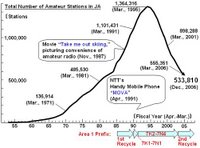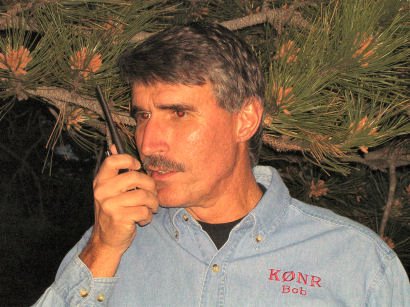How Many Amateur Radio Operators are there in Japan?
 I recently came across a web page maintained by Ryota "Roy" Motobayashi, JJ1WTL / AC6IM that explains the Japanese amateur radio callsign system. I used to hold a Japan amateur radio license (reciprocal, based on my US license) with callsign 7J1AUE. I was traveling to Japan on business at the time, so I wanted to do some radio operating while I was there. I have since let the license lapse as it is expensive and a hassle to renew each year.
I recently came across a web page maintained by Ryota "Roy" Motobayashi, JJ1WTL / AC6IM that explains the Japanese amateur radio callsign system. I used to hold a Japan amateur radio license (reciprocal, based on my US license) with callsign 7J1AUE. I was traveling to Japan on business at the time, so I wanted to do some radio operating while I was there. I have since let the license lapse as it is expensive and a hassle to renew each year.This web page had an interesting chart of Japanese amateur radio station licenses by year, showing a steep decline starting in 1995. (Click on the graphic to the left to make it larger.) Historically, Japan had more amateur radio licensees than the US but this appears to have changed. According to this chart, the number of station licenses in Japan has dropped to less that 534k last year while the number of US licensees is around 655k (according to the AH0A web site).
This is a bit of an apples-to-sushi comparison since the Japan system includes a station license and an operator license. However, the simplest reasonable comparision is to compare Japan station licenses to US operator licenses. Japan station licenses have a 5 year renewal term while the US licensees are valid for ten years. This increases the difficulty of a comparison as it affects the statistics in an environment where radio licenses are not being renewed. Actually, there are other issues identified by AH0A that need to be considered when making these comparisons.
Of course, most of the major amateur radio equipment manufacturers are located in Japan, so the Japanese ham market has an effect worldwide. Some examples: There has never been much 222 MHz radio equipment available, because there is no 222 MHz band in Japan. Ever notice that the CTCSS tone defaults to 88.5 Hz on Japanese radios? That's the de facto standard for CTCSS in Japan. The "call" button on most Japanese FM rigs comes from the fact that in Japan there really is a calling frequency that you call on and announce that you'll be listening on another frequency. (So you want to be able to QSY quickly on/off the call frequency.)
Anyway, the decline in Japan ham licenses is probably a leading indicator for the rest of the world, including the US. It also seems in line with general indications that the R&D investment into ham radio gear is slowing, with fewer rigs with fewer innovations being introduced each year. In the business world, they call that "a mature market".
73, Bob K0NR



3 Comments:
Thank you for the article on the decline of Amateur Radio in Japan. Many in radiosport are wondering what happened to the dependable JA-runs of the lore years.
73 de Scot, KA3DRR
When I moved out from the Midwest to the Pacific Northwest, I was expecting to hear a lot more JA's then from the Midwest or East Coast where I had done a lot of contesting.
It has not turned out that way. And the CW JA runs were just tons of fun to work during a contest.
Times change.
Thanks for doing the research.
Scot, K9JY
If you notice the decline started exactly in 1995. Can you recall what seachange occured in that year? Windows 95 and the computer/internet revolution in Japan, that's what. Japan has never been the same.
Akihabara was an electronics haven, with little to no computer stores in 94. One year later, Sofmap, et al, took over the town. Now, look at it. It's 99% computer related goods. It began in '95. The attraction of Ham, worldwide communication, tech stuff, building electronics, working on pet projects that never have to end, all these shifted from electronics to computers.
Post a Comment
Links to this post:
Create a Link
<< Home